PowerColor X800 GT EVO Tide Water 256MB II
Leading on from the card and block and connected via the two hoses on the previous page, is a self-contained pump, radiator and fan assembly.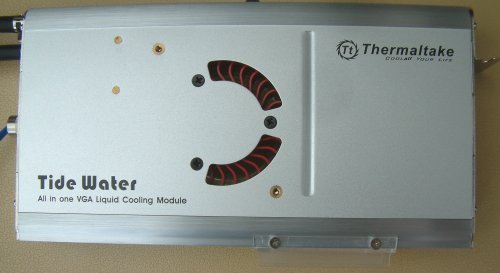
What you're looking at is the upper side of the self-contained unit that fits into regular cases. The two hoses which are used to push the liquid around the system are situated on the right-hand side, so let's take a look.
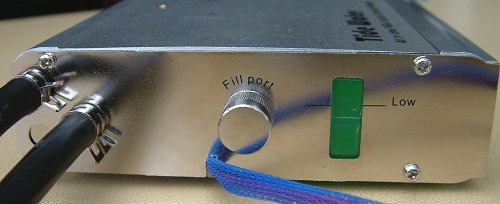
Designed by Thermaltake, dubbed Tide Water, it's the first liquid-cooling system we've seen thus far that's architected solely for graphics card cooling. What's more, there's no reason why the Tide Water system cannot be used for other graphics cards, assuming a decent-fitting block. A fill port and level indicator, ensuring that the right amount of liquid is in the system, are both necessary. Thermaltake reckons that the liquid is good for up to 10,000 hours of maintenance-free use, too. The blue cable connects the Tide Water system to a spare 12v molex connector.
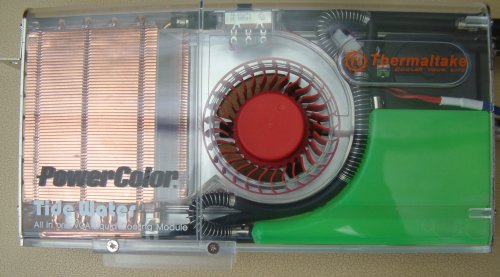
Turning it over shows exactly how the Tide Water system works. A tiny pump, on the upper right-hand side, pushes the green cooling liquid to the block. The block then picks up the GPU's heat, transfers it to the liquid, which is then pumped back to the self-contained unit and through the copper radiator on the left-hand side. By dint of the fact that the Tide Water is located inside a case, the large fan, right in the middle, is required to further cool the liquid as it passes through the radiator and eventually ends up at the reservoir at the bottom and back out via the pump again. The whole process then begins again; classic watercooling.

A gratuitous shot of the copper radiator. The fan pushes air across the numerous fins and out through the back. The double-height nature of the PCI plate means that the Tide Water system takes up two PCI slots, so make sure you have enough room, as the GPU PCB will inevitably take up a PCI-Express slot.
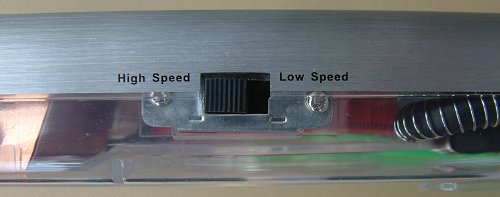
A handy switch allows you to toggle the fan-speed from low (1,700RPM, barely audible) to high (3,000RPM, very noticeable). The faster the fan speed, the better the radiator cooling and, ergo, the better the overall Tide Water performance.
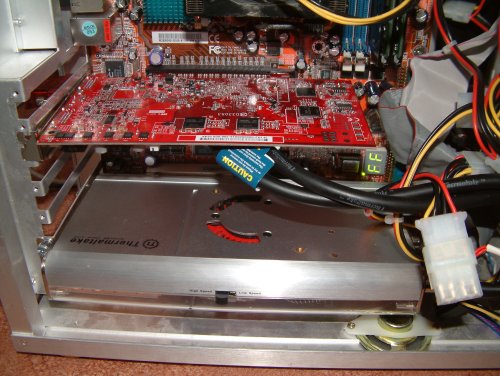
There you have it. The Tide Water unit actually plugs into 2 PCI slots and is secured around the back. Users with PCI/PCI-Express (x1) cards may find that the Tide Water system takes up a little too much space, however.
There's no doubting that the collaboration between PowerColor/TUL and Thermaltake has produced a one-of-a-kind graphics card package, but we reckon that the basic design could be improved upon further, especially with respect to PowerColor. With liquid-based cooling it would have been nice to have temperature measurements for both card core and memory. Further, considering that the GT EVO edition features 1.6ns memory, an all-in-one core/memory block would have made decent sense. Thermaltake does offer the user a choice between two fan speeds, sure, but the aural difference between 1,700RPM and 3,000RPM is significant. Something like a rheobus would have been ideal, allowing you to choose the fan-speed between the two limits.
The Tide Water package is expected to retail at around £199.99. That's almost double the asking price of a regular X800 GT 256MB package. We appreciate the fact that the Tide Water X800 GT 256MB has overclocked core and memory speeds of 500MHz/1050MHz, respectively, but we wonder whether the addition of a discrete liquid-cooling unit has priced it above the sweetspot for X800 GT cards? Whatever the case, it's refreshing to see something new.









